Houseflies (Musca domestica) are non-biting nuisance insects that occur worldwide.
They are a probably the most cosmopolitan insect species. They are found everywhere, from to the Polar regions to the tropical forests, mostly associated with human activities.
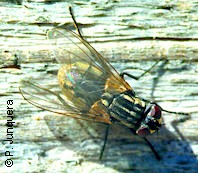
The housefly is a universal pest in or around livestock facilities such as stables, barns, poultry houses, piggeries, etc., particularly in pig, poultry, dairy and feedlot facilities. And it is one of the most difficult to control.
This is due to its ability to feed on almost any kind of organic material and to develop on almost any kind of organic substrate. On top of it, houseflies are world champions in developing resistance to insecticides.
Strictly speaking houseflies are not parasites, because they do not live at the expense of other living organisms. In fact, they do not bite, and can survive without animal hosts. But they can transmit several human and animal diseases and numberless food contaminants.
Biology, life cycle and behavior of houseflies
Adult houseflies are medium-size Dipteran insects, 7 to 11 mm long. As all Dipterans they have one pair of wings. They feed on fluids rich in sugars and proteins, which they suck with their mouthparts that include a proboscis, a retractile kind of flexible tube. If the substrate is solid, they dissolve it with regurgitated saliva.
They constantly fly around, stop in numberless places and check the substrate with their proboscis for identifying food. This behavior and the anatomy of their legs make houseflies to highly efficient transmitters (vectors) of dozens of contaminant and pathogen bacteria and fungi. Houseflies are also excellent fliers: flights of over 30 km have been recorded for individual flies.
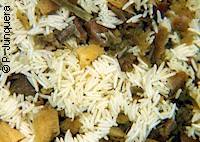
The life cycle can be completed in less than 2 weeks. They breed in any kind of manure (especially if it is mixed with hay or straw), in garbage, and on whatever decaying organic material, e.g. rests of animal feed.
A female fly deposits up to 900 eggs in packages of 75 to 150 eggs at a time. Eggs hatch 1 to 2 days later and the larvae develop to pupae in about 6 days. Mature larvae usually leave the breeding medium in search of a dryer environment in the soil where they pupate. Five days later adult flies hatch out of the pupae.
Temperature and humidity determine the duration of the life cycle. The more humid and warmer, the faster is development. In regions with moderate climate 8 to 12 generations are possible within a season, even more in tropical regions.
Adult flies live only for a few weeks, longer by cold weather. Both adults and pupae overwinter in manure or garbage piles, rubbish dumps, inside stables, barns, etc.
Click here to learn more about the general biology of insects.
Harm and economic loss due to houseflies
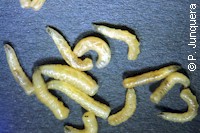
Houseflies are neither directly harming nor highly annoying to livestock, certainly not as much as numerous other biting insects. But they are mechanical vectors of all kinds of pathogens and contaminants: virus, bacteria and other microbes.
More than 100 diseases and contaminants have been reported to be potentially transmitted by houseflies, e.g. Salmonella, anthrax, mastitis, conjunctivitis, cholera, botulism, tuberculosis, Newcastle disease, Giardia, etc. Houseflies can also transmit viable eggs of various parasitic worms (e.g. Ascaris spp).
Being a "mechanical vector" means that the microbes do not spend part of their life cycle inside the fly's organism, as it happens with many other microorganisms. Houseflies simply transport them from one place to another one sticking to their mouthparts or their legs.
Houseflies can be a serious issue for livestock operations that have become too close to newly developed peri-urban residential areas. Legal suits due to fly nuisance can have a significant economic impact for producers.
Houseflies are usually not a relevant issue for dogs and cats. Pet owners are likely to suffer more from houseflies than their pets.
Non-chemical prevention and control of houseflies
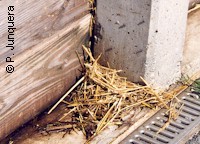
Houseflies can be a serious economic problem in poultry operations, especially in battery layers with manure accumulation. Broiler operations on dry bedding withcomplete removal after a cycle usually have less housefly problems. But in fact, everywhere in poultry operations manure or feed waste will remain deposited in numberless places: below or around feeders, below slatted floors, in drains, pipes, sewers, cracks and crevices in the soils or walls, etc. All these places are suited to support fly breeding.
Houseflies can be a serious problem in intensive pig operations as well, and of course in traditional piggeries. Even if sophisticated manure removal systems are on place, it is simply impossible to avoid depositing of manure and food waste in numerous cracks, cornes, crevices, etc.
In fact, in every livestock operation - dairy farms, feedlots, stables, etc. - remains of feed and manure, often mixed with hay, straw or bedding are ubiquitous, and they are mostly humid thanks to urine or sprinkling water. This mix is ideal for housefly breeding.
It is almost impossible to completely avoid the presence of houseflies in livestock operations. But it is possible to prevent them from becoming a pest. A dozen houseflies are normally not an issue. But thousands of houseflies are indeed a problem.
For successfully controlling houseflies it is highly recommended to follow Integrated Pest management (IPM) programs that combine all available approaches to pest control: structural, operational, biological and chemical.
Traps to catch and kill houseflies without chemicals (e.g. electrocuting traps, sticky traps, etc.) can be quite effective, sometimes enough to keep the fly population below a certain annoyance threshold level, especially indoors.
There are no natural repellents capable of keeping houseflies away from livestock, manure or organic waste.
Manure management
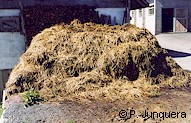
The key to housefly prevention is removing as effectively as possible whatever can serve as a breeding substrate for the flies (i.e. any kind of organic material such as manure, feed or silage waste, remains of hay, straw, bedding, crashed eggs, carcasses, etc.). If it cannot be removed, it must be kept dry.
To ensure this, plumbing and hosepipes must be leak-free and regularly maintained, and rainwater must be properly drained. Air circulation over accumulated manure must be favored, e.g. with electric fans. The way to implement this strongly depends on type and size of the operation and on the surface available for manure or waste disposal.
Biological control
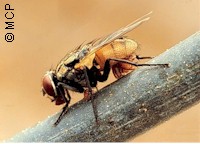
Biological control of houseflies with their natural enemies can be quite effective if the environmental and ecological conditions required by such natural enemies are ensured. This requires a minimum usage or chemicals, larvicides or insecticides, because most of them are also lethal for the beneficials.
The most effective enemies of houseflies are:
- - Hymenopteran wasps (e.g. Spalangia spp) that deposit their eggs on housefly pupae
- - Beetles (e.g. Carcinops spp) that feed on housefly eggs and larvae
- - Mites (e.g. Machrocheles spp) that feed on housefly eggs and larvae. Adult female mites attach to houseflies that bring them to new hunting grounds.
As a general rule, keeping the manure dry helps these predators to find and destroy fly eggs and larvae.
Some natural pathogens can be also effective in controlling housefly populations, e.g. Entomophtora muscae, a microscopic fungus. Other insect pathogens such as Bacillus thuringiensis are less adequate because they are also pathogen for the beneficial fauna.
As a general rule, biological control of houseflies can be quite successful in confined poultry, pig and dairy operations. However it is technically quite demanding and requires appropriate training of workers. If at all, it is much less successful in outdoor operations.
Learn more about biological control of flies and other insects.
Chemical prevention and control of houseflies
With ADULTICIDES
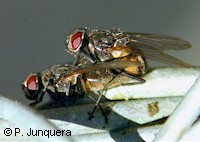
Spraying insecticides on the surfaces preferred by the flies for landing (walls, ceilings, posts, fences, etc.) can be quite effective. Most products for surface spraying kill the adult flies by contact (so-called adulticides). A few products are not sprayed but painted on such surfaces (paint-on insecticides), often after being mixed with sugar. They contain oral insecticides, i.e., the flies have to feed on them. Most products for surface treatment contain classic veteran insecticides such as:
- Organophosphates, e.g. diazinon, chlorpyrifos
- Carbamates, e.g. propoxur, carbaryl
- Synthetic pyrethroids, e.g. cypermethrin, deltamethrin, permethrin
- Neonicotinoids, e.g. imidacloprid
- Phenylpyrazoles, e.g. fipronil
Depending on the active ingredient of the product and the type of surface (wood, plastic, metal, etc.) the applied insecticide will remain active for several weeks (residual effect). Efficacy will be progressively reduced by regular washing and sprinkling, and by dust and dirt that deposits on the treated surfaces.
Baits with insecticides can also be quite effective. They are available as scatter baits, already applied to cardboard or paper strips, etc. These baits also contain classic veteran insecticides such as those for surface spraying, but also newer ones such as spinosad. Baits are often combined with fly attractants, mostly Z-9-tricosene, a sex pheromone released by females to attract males. Most baits also have a bitterant, i.e. a substance that makes the bait extremely bitter to prevent human ingestion.
Fumigation of insecticides makes only sense to immediately reduce an excessive fly population indoors. But it kills only those flies that are caught in the mist during application. Fumigation has no residual effect. Fumigation usually requires special equipment. To be effective air circulation must be interrupted in the fumigated premises. Fumigation may require emptying the premises from animals to prevent poisoning. Products for fumigation contain mostly veteran insecticides such as organophosphates and synthetic pyrethroids, often mixed withsynergists.
It is never a good idea to directly treat the animals with insecticides in order to kill adult houseflies (e.g. with dips, sprays, pour-ons, ear-tags, dusts, etc.). First, because houseflies land only very shortly on the animals, since they feed on any organic material, which they can find in excess off the animals: very few flies would be killed. Second, because many insecticides for surface treatment are only approved for off-animal use, and treating livestock with such products bears the risk of poisoning or of illegal residues in meat, milk or eggs.
There are no synthetic chemical repellents capable of keeping houseflies away from livestock, manure or organic waste material.
With LARVICIDES
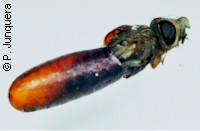
Larvicides kill the immature stages of the flies in their breeding environment. Products for this purpose are mostly applied directly on the manure heaps, or for spraying floors, drains, crevices, etc. where fly maggots could hide. This process is sometimes called larviciding. Such products are available as sprays, granules, powders, etc.
Besides classical veteran larvicides (e.g. organophosphates, carbamates, synthetic pyrethroids, neonicotinoids) that kill the larvae, insect development inhibitors are also used (e.g. cyromazine, diflubenzuron, triflumuron, etc.) that do not immediately kill the larvae, but interrupt their development to adult flies. The drawback of such products is that they are also detrimental to the beneficial dung fauna, with the exception of cyromazine that is quite specific for houseflies.
In some countries there are larvicides available as feed additives for poultry (e.g. with cyromazine). After ingestion by the birds the active ingredient is excreted unchanged in the feces and prevents the development of flies in the manure. Since all the feces are treated it is a very effective means of housefly prevention and control.
Combined Use of Adulticides and Larvicides
It is highly advisable to combine the use of adulticides with larvicides. The major reason is to prevent or at least delay the development of resistance by the houseflies. This makes a lot of sense because larvicides and adulticides have different modes of action. If an adulticide selects flies that are resistant to it, they are most likely to still be susceptible to the larvicide, and vice-versa.
A possible approach is to alternate them, e.g. every three months (a process usually called rotation). Another approach is to use larvicides at the beginning of the fly season to prevent large fly populations to develop, and at the end of the season, to reduce the number of overwintering flies that will re-start the infestation in the next season. Adulticides can be used in between according to the infestation levels.
| If available, follow more specific national or regional recommendations or regulations for housefly control. |
Click here to learn more about surface and environmental treatments.
Insecticide resistance of houseflies
Houseflies are the world champions in developing resistance to pesticides. Resistance has been reported for virtually all chemical classes of pesticides. There are even strains resistant to Bacillus thuringiensis, a bacterial pathogen of insects.
Resistance occurs worldwide and can be that high, that the flies survive the contact with undiluted concentrates. There are reports of resistance to organochlorines, organophosphates, carbamates, synthetic pyrethroids, insect development inhibitors, neonicotinoids, phenylpyrazoles, macrocyclic lactones, spinosyns, etc. For the newest active ingredients (e.g. metaflumizone, spinetoram, spinosad) field resistance has not yet been reported, but the past experience strongly suggests that it is only a matter of time for it to appear.
There are also numerous multi-resistant strains, i.e. populations that are simultaneously resistant to two or more chemical classes with different mechanisms of action, e.g. organophosphates carbamates and pyrethroids).
A practical consequence of this is that if a particular product does not achieve the expected control of houseflies, it is reasonable to consider a resistance problem, especially if that product has been used for several consecutive years without rotation. However, experience shows, the most cases of product failure are due to incorrect use of the product.
In addition to product rotation, the best way of delaying resistance development is to follow Integrated Pest management (IPM) programs that combine all available approaches to pest control: structural, operational, biological and chemical.
Learn more about parasite resistance and how it develops.